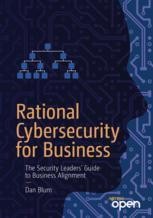
|
FreeComputerBooks.com
Links to Free Computer, Mathematics, Technical Books all over the World
|
|
- Title: Rational Cybersecurity for Business: The Security Leaders' Guide to Business Alignment
- Author(s) Daniel Blum
- Publisher: Apress; 1st edition; eBook (Creative Commons Licensed)
- License(s): Creative Commons License (CC)
- Paperback: 360 pages
- eBook: PDF and ePub
- Language: English
- ISBN-10/ASIN: 1484259513/B08FSXMVR7
- ISBN-13: 978-1484259511
- Share This:

|
Use the guidance in this comprehensive field guide to gain the support of your top executives for aligning a rational cybersecurity plan with your business.
This open access book presents six priority areas to focus on to maximize the effectiveness of your cybersecurity program: risk management, control baseline, security culture, IT rationalization, access control, and cyber-resilience. Common challenges and good practices are provided for businesses of different types and sizes. And more than 50 specific keys to alignment are included.
It presents valuable lessons learned from interviews with over 70 security and business leaders. You will discover how to successfully solve issues related to: risk management, operational security, privacy protection, hybrid cloud management, security culture and user awareness, and communication challenges.
About the Authors- Daniel Blum is an internationally recognized cybersecurity and risk management strategist.
- Computer, Networks, and Information Security
- Networks Security and Management
- Computer Network and Communications
 Similar Books:
Similar Books:
-
 Cybersecurity: Public Sector Threats and Responses
Cybersecurity: Public Sector Threats and Responses
Focuses on the convergence of globalization, connectivity, and the migration of public sector functions online. It examines emerging trends and strategies from around the world and offers practical guidance for addressing contemporary risks.
-
 Maritime Cybersecurity (Sanja Bauk)
Maritime Cybersecurity (Sanja Bauk)
Highlights the importance of cybersecurity in the maritime domain, including the human and societal aspects of both cyber-crime and cyber-defense. Emphasizes the importance of protection against cyber-attacks at operational, tactical, and strategic levels.
-
 Security Technologies and Methods for Advanced Cyber Threats
Security Technologies and Methods for Advanced Cyber Threats
This open access book presents six priority areas to focus on to maximize the effectiveness of your cybersecurity program: risk management, control baseline, security culture, IT rationalization, access control, and cyber-resilience.
-
 Security Concepts (Subspacefield)
Security Concepts (Subspacefield)
This is a book about computer, network, technical, physical, information and cryptographic security, illustrated with interesting and entertaining examples. It is not intended to be an introductory text, although a beginner could gain something from it.
-
 Security of Ubiquitous Computing Systems (Gildas Avoine, et al)
Security of Ubiquitous Computing Systems (Gildas Avoine, et al)
It is to improve and adapt existent cryptanalysis methodologies and tools to the ubiquitous computing framework that lies along four axes: cryptographic models, cryptanalysis of building blocks, security engineering, and security assessment.
-
 Security Engineering: Building Dependable Distributed Systems
Security Engineering: Building Dependable Distributed Systems
It makes it clear just how difficult it is to protect information systems from corruption, eavesdropping, unauthorized use, and general malice, offers a lot of thoughts on how information can be made more secure by both technologies and strategies.
-
 Computer Security Handbook (Seymour Bosworth, et al.)
Computer Security Handbook (Seymour Bosworth, et al.)
This handbook has compiled advice about how to minimize the possibility of computer security breaches in your systems. It provides comprehensive best guidance about how to minimize hacking, fraud, human error, the effects of natural disasters, and more.
-
 Handbook of Information Security Management (Micki Krause)
Handbook of Information Security Management (Micki Krause)
Bringing together the knowledge, skills, techniques, and tools required of IT security professionals, it facilitates the up-to-date understanding required to stay one step ahead of evolving threats, standards, and regulations.





